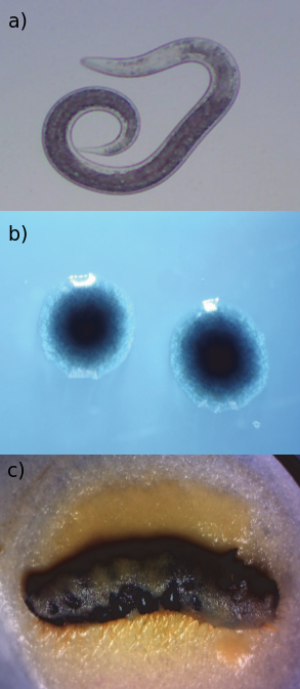Table of Contents
Group 3
<html><font size=6 face=“Arial”>Bacteria fight dirty: competition vs reproduction in a bacteria symbiont of a nematode</font></html>
Wiki site of the practical exercise of the VIII Southern-Summer School on Mathematical Biology.
Here you will find the exercise assignment and the group's products.
If you are a group member login to edit this page, create new pages from it, and upload files.
Introduction
 Symbiosis can be defined as “an interaction (positive, negative, or neutral) in which two species exist in intimate physical association for most or all of their lifetimes and are physiologically dependent on each other” [1]. This is the interaction between the bacteria Xenorhabdus bovienii and its host, the nematode Steinernema affine, on which it depends to colonize insects [2]. They infect the insect (caterpillars, for instance), get separated, and then both contribute to kill it. Once dead, the insect provides resources that allow reproduction of both species. When these resources are depleted, the bacteria and the nematode reunite and emerge from the insect.
Symbiosis can be defined as “an interaction (positive, negative, or neutral) in which two species exist in intimate physical association for most or all of their lifetimes and are physiologically dependent on each other” [1]. This is the interaction between the bacteria Xenorhabdus bovienii and its host, the nematode Steinernema affine, on which it depends to colonize insects [2]. They infect the insect (caterpillars, for instance), get separated, and then both contribute to kill it. Once dead, the insect provides resources that allow reproduction of both species. When these resources are depleted, the bacteria and the nematode reunite and emerge from the insect.
Xenorhabdus is able to produce a compound (bacteriocin) that inhibits bacteria from different strains inside the insect. Inhibiting strains of the bacteria show a clear advantage over non-inhibiting ones when they reproduce together inside the insect. However, non-inhibiting strains of Xenorhabdus are observed isolately, but generally not together with inhibiting strains. So how can both types persist in nature? That is the question that the authors of [2], and perhaps yourselves, try to answer.
They hypothesize that there may be a reproductive cost for the bacteria associated with inhibiting other strains, and experimentally test it. Their results suggest that, indeed, on a non-competitive environment, non-inhibiting strains of Xenorhabdus are able to kill and reproduce faster than inhibiting ones.
<WRAP clear></WRAP>
<WRAP third column right> Figure: Top - Nematode (Steinernema affine). Middle - Bacteria (Xenorhabdus bovienii). Bottom - Caterpillar (Malacosoma americanum). Source: [2]</WRAP>
<WRAP clear></WRAP>
Assignment
Propose and analyse a mathematical model that incorporates the interactions and describes the dynamics of the species in this system.
Questions & Suggestions
- Does your model allow some kind of coexistence between inhibiting and non-inhibiting bacteria?
- Can the dynamics of the insect host drastically change your conclusions?
- The bacteria used in the experiment (both inhibiting and non-inhibiting) are equally able to resist inhibition. Does incorporating bacteria less sensitive to bacteriocin in the model change your main results?
References
- Levin, Simon A., et al., editors. The Princeton Guide to Ecology. Princeton University Press, 2009.
- Bertoloni Meli S, Bashey F. Trade‐off between reproductive and anti‐competitor abilities in an insect–parasitic nematode–bacteria symbiosis. Ecol Evol. 2018;8:10847–10856. https://doi.org/10.1002/ece3.4538
- Martens , E. C. , Heungens , K. , & Goodrich-Blair , H. (2003). Early colonization events in the mutualistic association between Steinernema carpocapsae nematodes and Xenorhabdus nematophila bacteria .
